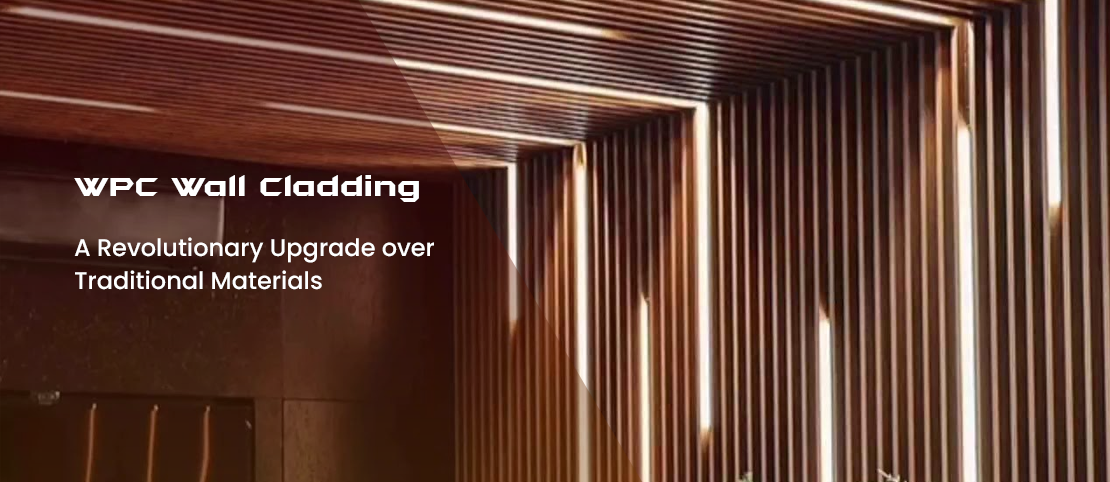Cladding is the protective and decorative layer or covering applied to the exterior or sometimes interior of a building or structure, influencing its aesthetics, insulation, and overall durability. In the realm of wall cladding, Wood-Plastic Composite (WPC) is a transformative material that has been given rise due to innovation and sustainability. Overshadowing traditional cladding materials with its numerous advantages, this dynamic material has taken the construction and design industry by storm. Let’s investigate into why WPC wall cladding is a superior choice, far surpassing the capabilities of its older counterparts.
Traditional Cladding Materials
Traditionally, cladding consists of wood, stone, brick, and metal, each with its distinct characteristics.
- Natural Wood Cladding:
One of the earliest and most traditional cladding materials is wood which emanates a warm and inviting aesthetic. For both interior and exterior cladding its natural grains and textures create a connection with the environment, making it a popular choice. The disadvantage is that it requires regular maintenance, prone to decay, and can be costly.
- Stone Cladding:
Stone cladding is equal in strength, durability, and sophistication. Stone cladding offers a diverse range of textures and colors from the rustic charm of stacked stones to the refined elegance of marble. The disadvantage lies in its heaviness, expensive installation, and challenge to modify.
- Brick Cladding:
The brick cladding has an ironic antiquity dating back centuries. In architectural designs across the globe, its versatility, durability, and excellent thermal properties have made it a staple. The disadvantage lies in its limited design options, heaviness, and energy-intensive production.
- Vinyl Cladding:
Vinyl cladding has the advantages of being affordable, lightweight, low maintenance, and versatile. It has a disadvantage in that it is less eco-friendly, can fade, and is prone to damage.
WPC Wall Cladding
Choosing the right cladding material is essential when it comes to enhancing the aesthetics and structural integrity of a building. In recent years, Wood-Plastic Composite (WPC) wall cladding providing a host of advantages that set it apart from traditional options, has emerged as a revolutionary choice. Wood-Plastic Composite (WPC) is a composite material composed of wood fibers, wood flour, and thermoplastics, primarily recycled polyethylene or polyvinyl chloride (PVC). The blend of these materials results in a unique product that embodies the qualities of both wood and plastic, presenting a compelling solution for various applications, including wall cladding.
WPC Wall Cladding Material
The building material of WPC wall cladding involves combining wood fibers or flour with plastic polymers. The wood component mimicking the appearance of traditional wood provides natural aesthetics, texture, and rigidity. On the other hand, the plastic component enhances the resistance to moisture, the material's durability, and overall stability.
Key Features of WPC Wall Cladding
Aesthetic Versatility:
Bid farewell to the demanding repairs associated with natural wood and other traditional materials. WPC wall cladding does not require painting, sealing, or staining to retain its aesthetic allure. A simple wash now and then suffices, leaving you with more time to appreciate your cladding and less time to maintain it.
Low Maintenance:
WPC wall cladding requires minimal maintenance compared to natural wood. It does not need sealing, staining, or painting. Routine cleaning to remove dust and dirt ensures the cladding retains its pristine appearance over time.
Durability:
In the face of various environmental factors, WPC wall cladding excels in durability, showcasing immense resilience. Unlike traditional wood, which is susceptible to corrosion, decay, and insect damage, WPC is engineered to sustain. It doesn't splinter, crack, or warp, providing a lasting exterior that can weather the test of time.
Environmentally Friendly:
WPC promotes sustainability by reducing the demand for virgin materials by utilizing recycled wood fibers and plastic polymers. Additionally, it contributes to a greener construction industry and reduces plastic waste.
Easy Installation:
WPC wall cladding is crafted with a user-friendly design, facilitating straightforward installation. Commonly utilizing a tongue-and-groove system, it streamlines the installation procedure, rendering it ideal for individuals interested in DIY projects.
Cost-Effective in the Long Run:
The long-term savings are substantial though the initial investment in WPC might be slightly higher than traditional materials. Considerable amounts of maintenance, repairs, and replacements can be saved due to the longevity and minimal maintenance requirements of WPC. Thus WPC proves to be a cost-effective option that adds value to your venture.
Excellent Thermal and Sound Insulation:
Superior insulation properties have been claimed by Wood-Plastic Composite wall cladding. Aiding in maintaining indoor temperatures and contributing to energy efficiency it acts as a reliable thermal barrier. Moreover, enhancing the acoustic comfort of your space it acts as an effective sound insulator.
A new standard in the construction industry has undoubtedly been set by Wood-Plastic Composite (WPC) wall cladding. Its properties make it a material of choices like durability, low maintenance, sustainability, design versatility, insulation properties, and cost-effectiveness. Opting for WPC instead of conventional materials is a choice that enhances your environment and corresponds with sustainable principles.
Embrace the future of wall cladding solutions with MBT. Choose WPC from MBT and experience the epitome of innovation and sustainability.
